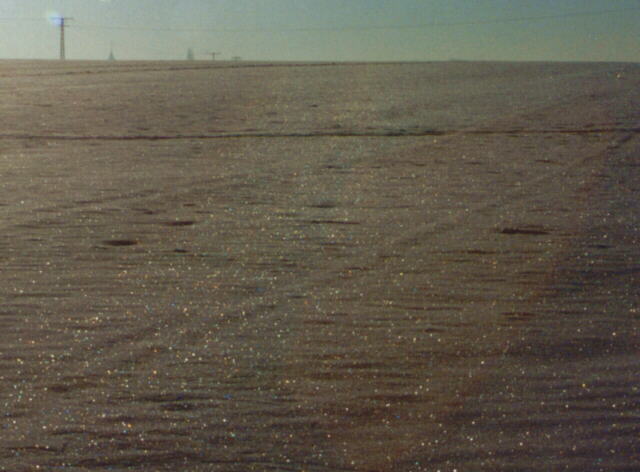After a clear and very cold night with -16.5°C in the early morning (ground: -22°C) on 10.12, everything was covered with fan-shaped hoarfrost. Even the crystals on the snow surface were so frozen that they took on structures similar to hoarfrost. When I cast my gaze over a larger snow surface after sunrise, I was surprised because what I saw there was a "double" snow halo. The 22° ring was actually surrounded by a 24° ring. I had hardly thought it possible - pyramidal crystals on a snow cover! The 46° ring also appeared through an accumulation of colorful light points. However, it was hardly distinguishable from the glitter of the frozen snow. Nevertheless, it became clearer with the increasing height of the sun (as in my first observation on 30.12.1996), especially on the site of the future Lausitzring (huge open area).
The greatest intensity of the 3 rings was, as the day before, at the lateral edges. Since the wind factor no longer played a role that day, the effect can probably only be explained by the distance-related concentration of crystals. It is peculiar only that this effect has never occurred in all previous observations. In those, the greatest intensity was always at the lower edge, since with distance, that is towards the horizon, the light points became weaker and thus less perceptible to the eye.
Perhaps I should first ask myself the question, where do the ice crystals come from at all?! Since with the 24° ring a new phenomenon appeared compared to the previous day, it can no longer be the ice pellets from 8.12, which might have long since lost its effect. New ice crystals must have been responsible for the strange phenomena. However, there had been no snowfall the previous night. Could it be the hoarfrost that also formed directly on the snow surface the previous night? But what about the frost on plant stems near the ground? In fact, the fan-shaped hoarfrost crystals on plants showed no light refraction effects. Even the hoarfrost shaken from trees did not succeed in even indicating the 22° halo by the glitter of the crystals. Observations from the winter of 96/97 also show that after extremely cold nights, fan-shaped hoarfrost appeared without any light refraction effects. So the hoarfrost also does not seem to be the cause of the new snow halos. But where did the crystals come from then? T. Lehmann reported local fog near the ground on the site of the future Lausitzring shortly after sunrise on his way to school. He also mentioned ice crystals floating in the air that glittered in the light of the rising sun. There is now suspicion that the corresponding ice crystals formed as ice fog and gradually settled on the ground. This could also explain the previously not observed 24° ring on snow, which was at least as distinct as the 22° ring. The hypothesis is supported by the fact that the snow halos only appeared on larger open areas and not, for example, in the garden, since fog at ground level tends to form in open country. While the 24° ring was only observed on a snowy field on the edge of Klettwitz, 22° and 46° rings also appeared on other surfaces. Apparently, pyramidal crystals only formed in the fog on that specific field and not elsewhere, which further limited the spread of the 24° ring. The formation of specific ice crystals in ice fog seems to be locally dependent even in lowlands.
With the ice fog theory, the concentration of light at the lateral edges of the rings can perhaps also be explained, assuming that the ice crystals reached the ground in a slightly oriented position due to the calm air and thus created an accumulation of light refractions near the horizon. However, to make this statement credible, the structure of the ice crystals should have been examined, for which I unfortunately had no opportunity.

